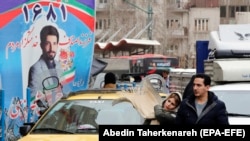This week, the Islamic Republic in Iran will hold an unfree and unfair election for the 290 seats in its national parliament, the Islamic Consultative Assembly. Over the last four decades, on average, the regime has held one major election per year, all of which it rigged in more or less obvious ways. If the Islamist regime in Tehran is as authoritarian as its critics claim, why does it hold so many elections, and why does it let voters determine some of the outcomes?
In part, Tehran maintains a democratic façade to increase its prestige on the global stage. More importantly, the regime wants to keep alive millions of Iranians’ hope that reform is possible without mass demonstrations or violence. The third and least understood motive for elections is to distribute power and wealth to regime loyalists while creating the impression that voters chose to do so, rather than the supreme leader, Ayatollah Ali Khamenei.
Spokesmen for the regime insist that it practices Islamic democracy. More sophisticated apologists concede that Iran’s elections are less than free and fair, but evolving gradually in the right direction. Yet since the Islamists seized power in 1979, there has been no progress toward democratization. Instead, the regime has oscillated between pure dictatorship and what political scientists call a hybrid regime or competitive authoritarianism.
By handpicking the candidates for every election, the regime drastically narrows the range of competition. The 12 members of the Guardian Council approve safe candidates and disqualify numerous others, yet the Council is just a tool of the supreme leader; he directly appoints six of its members, while the head of the judiciary—himself appointed by the supreme leader—recommends the other six.
Competition also presents few risks because the Guardian Council must approve any measure passed by the Consultative Assembly before it becomes law. Khamenei has further restricted the power of elected officials by creating parallel institutions and transferring executive and legislative power to them. Additionally, through a sham privatization process Khamenei has transferred billions of dollars of assets, previously controlled by the executive branch, to the Islamic Revolutionary Guards Corps (IRGC) and his own business empire.
For all these reasons, elections are a safe bet. Besides, as the regime made clear following the presidential election of 2009, it has the ability to falsify results and violently suppress the ensuing demonstrations.
Yet maintaining a democratic façade is safer than risking such explosions. The competition between pro-regime factions even leads many foreign observers to believe that there are meaningful differences between so-called “reformist” and “hardline” elements. The regime can also portray foreign pressure as illegitimate political warfare against an elected government.
Holding elections also preserves Iranians’ hope that reform is feasible through the ballot box. This charade was more convincing before the violence of 2009, but any kind of hope for peaceful change can be seductive when the alternative is to risk one’s life taking to the streets.The cost-benefit analysis only became clearer late last year, when the regime killed 1,500 protesters in less than a week.
To nurture false hopes, the regime does have to sacrifice some pawns on occasion, but even this sacrifice may be temporary. For example, General Mohammad Esmail Kowsari, the head of the Consultative Assembly’s defense and national security committee, lost his seat in the 2016 election. The supreme leader immediately appointed Kowsari as deputy commander of the IRGC’s powerful Sar-Allah Garrison, which is in charge of Tehran’s security. Kowsari then played a prominent role in crushing protests in 2017 and 2019, which resulted in hundreds of deaths. His replacements in the parliament did nothing to hold him accountable on behalf of their constituency.
Finally, elections provide a mechanism to distribute power and wealth among regime loyalists while relieving the supreme leader of responsibility for the outcome. Khamenei has absolute power, but knows that wielding that power to address every matter before the government would make him vulnerable. Khamenei depends on the pervasive corruption of the Iranian political system to reward regime loyalists, but elections make it seem that voters were the ones who gave power to corrupt individuals.
The Islamic Republic in Iran holds elections because the process benefits the regime. By allowing a limited competition among loyalists while controlling the participants and outcome, the regime grows more resilient in the face of pressure and more respectable abroad. With Khamenei at the height of his power and still healthy enough to be in charge, it is clear that the 2020 elections in Iran will lead to no fundamental political change.







